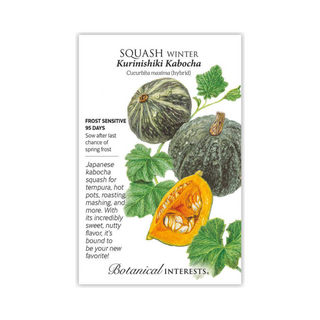
Description
Kurinishiki' is a small (3—4 pound), reliable kabocha squash. Kabocha means "pumpkin" or "winter squash" in Japanese and are traditionally made into soups or tempura. Use it just like any other winter squash, and the possibilities are endless. Similar to a sweet potato in flavor and texture, this squash is a favorite in many Asian countries. Allow room for vines ranging 4'—12' long. Stores up to 5 months.
Variety Info
- Days to Maturity: 95 days
- Family: Cucurbitaceae
- Type: Kabocha Squash, Winter Squash
- Native: Argentina and Uruguay
- Hardiness: Frost-sensitive annual
- Exposure: Full sun
- Plant Dimensions: 4'–12' vines
- Variety Info: 3–4-pound, flattened globe-shape fruits are dark, greenish-gray with pale green striping. Flesh is yellow-orange, very sweet, and smooth when cooked.
- Attributes: Frost Sensitive
Sowing Info
- When to Sow Outside: RECOMMENDED. 1 to 2 weeks after your average last frost date, and when soil temperature is 70°–85°.
- When to Start Inside: Not recommended except in very short growing seasons, 2 to 4 weeks before transplanting. Roots are sensitive to disturbance; sow in biodegradable pots that can be planted directly into the ground. Transplant when soil temperature is at least 60°F.
- Days to Emerge: 5–10 days
- Seed Depth: ½–1"
- Seed Spacing: 2–3 seeds per mound
- Row Spacing: 4'–12' apart
- Thinning: When 3" leaves, thin to 1–2 per mound
Growing Info
- Harvesting: Harvest when the squash's rind is hard enough that you can't dent it with your fingernail and before first frost. Cut stem, (don't break it off) leaving 2" of stem attached, which keeps the squash whole, leaving no opening for infection. Though fruits are hard and may seem indestructible, treat them gently; bruising can spoil squash.
Description
Kurinishiki' is a small (3—4 pound), reliable kabocha squash. Kabocha means "pumpkin" or "winter squash" in Japanese and are traditionally made into soups or tempura. Use it just like any other winter squash, and the possibilities are endless. Similar to a sweet potato in flavor and texture, this squash is a favorite in many Asian countries. Allow room for vines ranging 4'—12' long. Stores up to 5 months.
Variety Info
- Days to Maturity: 95 days
- Family: Cucurbitaceae
- Type: Kabocha Squash, Winter Squash
- Native: Argentina and Uruguay
- Hardiness: Frost-sensitive annual
- Exposure: Full sun
- Plant Dimensions: 4'–12' vines
- Variety Info: 3–4-pound, flattened globe-shape fruits are dark, greenish-gray with pale green striping. Flesh is yellow-orange, very sweet, and smooth when cooked.
- Attributes: Frost Sensitive
Sowing Info
- When to Sow Outside: RECOMMENDED. 1 to 2 weeks after your average last frost date, and when soil temperature is 70°–85°.
- When to Start Inside: Not recommended except in very short growing seasons, 2 to 4 weeks before transplanting. Roots are sensitive to disturbance; sow in biodegradable pots that can be planted directly into the ground. Transplant when soil temperature is at least 60°F.
- Days to Emerge: 5–10 days
- Seed Depth: ½–1"
- Seed Spacing: 2–3 seeds per mound
- Row Spacing: 4'–12' apart
- Thinning: When 3" leaves, thin to 1–2 per mound
Growing Info
- Harvesting: Harvest when the squash's rind is hard enough that you can't dent it with your fingernail and before first frost. Cut stem, (don't break it off) leaving 2" of stem attached, which keeps the squash whole, leaving no opening for infection. Though fruits are hard and may seem indestructible, treat them gently; bruising can spoil squash.

